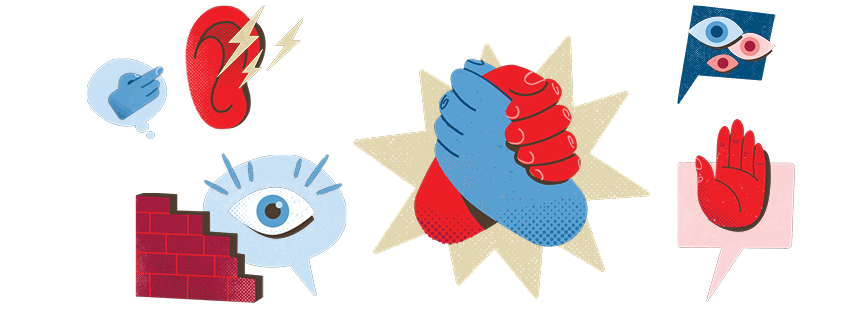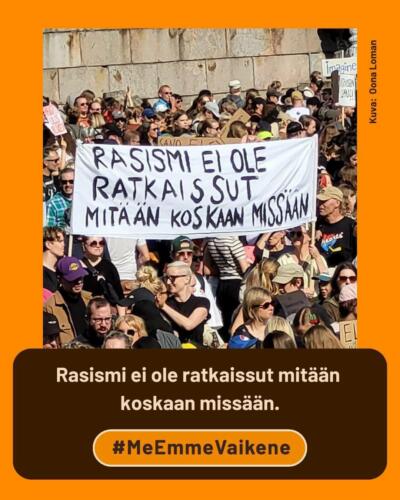Week Against Racism 2024: Interview with Lilja Lehmuskallio
In the Week Against Racism 2024 (18.3.-24.3.), student ambassador Haiyun Yu interviews Lilja Lehmuskallio, doctoral researcher in Arts Management at Uniarts.

Q: In your opinion, what is racism?
Good question to start with. And also important to remember, that the definition of racism is not based on opinions. I think this definition of the Australian Human Rights Commission is quite comprehensive: “Racism is the process by which systems and policies, actions and attitudes create inequitable opportunities and outcomes for people based on race. Racism is more than just prejudice in thought or action. It occurs when this prejudice – whether individual or institutional – is accompanied by the power to discriminate against, oppress or limit the rights of others.”. This definition of racism clearly depicts that it is a multifaceted process which involves both individuals and systems and is thoroughly related to positions of power. The roots of racism are also deeply and painfully intertwined in eugenics and in colonialism.
What is important to understand is that there are multiple ways in which racism occurs besides the visible racist attacks and hate crime, such as structural racism and microaggressions. Microaggressions are “casual” expressions which maintain racist stereotypes in eg. everyday encounters, and it is the responsibility of people who do not suffer from racism in their everyday life to educate themselves in these different manifestations of racism, to change their behaviour. In the Finnish context, racism does not concern just immigrants, refugees, or people with foreign backgrounds, but also for example the Roma and the indigenous Sámi. It is also crucial to understand that there is no such thing as reverse racism. There can be racial prejudice against white people, however that is not racism: racism is rooted in power.
Q: How is your current research related to anti-racism?
In short, my doctoral research deals with the position and representations of minority and marginalised groups in arts organisations, and the cultural policies which guide these organisations in matters concerning diversity and discrimination. Also, I teach and facilitate the course on Intercultural Communication Skills for master students, in which anti-racism and anti-racist practices are among the main themes. In terms of my research, understanding and writing about what racism and anti-racism means in institutional settings and finding out what are the best strategies for eliminating systemic racism from art institutional practices and processes, are in the core. I practice an intersectional research approach, which further helps in understanding and communicating about the intersecting aspects which cause multiple discrimination.
Being white, I must also constantly challenge myself to learn and unlearn the effects of growing up in racist societal structures and recognise the structures which uphold white supremacy both in everyday life, art fields, and in the academia. I also make it a priority to search for research literature made by people who belong in various marginalised groups, to ensure that diverse perspectives and different realms of knowledge-production are taken into account.

Q: Can you share some findings of your research related to this topic?
There is a lot of resistance in accepting how much there is racism in Finland. Art and cultural sector cannot be separated from the surrounding society, so it is important to understand that when research proves that Finland is one of EU’s most racist countries (European Union Agency for Fundamental Rights, 2019), that also involves our sector and educational institutions, and we need to take action accordingly. There is research and reports also straight from the arts and cultural sectors, such as the Finnish Actors Union’s survey (2022) which revealed that there is racism and discrimination in the acting field, and the Opening-report by Cupore – Cultural Political Research Center (Lahtinen, Mäenpää, Karri & Niiniaho, 2020) which showed for example that it is hard for cultural workers with a foreign background to be employed in the Finnish cultural sector. Just this week, Teosto (2024) published a survey in which it is revealed that more than 60% of the professionals who belong to an ethnic minority have experienced discrimination in the music field.
The questions of cultural appropriation in the arts are also closely related to racism, as dominant cultures are appropriating marginalised groups’ cultural expressions. Western cultural heritage museums are increasingly pushed to take action in repatriating/returning objects to their places of origin and in understanding the nature of these objects as something else than historical museum exhibits: that they are parts of living cultures and should exist in their rightful contexts. Especially important has been the discussion and actions considering human remains in museum collections.
Q: In your opinion, what kind of actions are needed to fight against racism in the Finnish society, especially in cultural and art sector?
Like writer and historian Ibram X. Kendi states, it is not enough to be not racist, we need to antiracist to be able to change the current institutions and societies and the deeply rooted systemic and overt racisms. Anti-racism is considered active action, so we should critically examine our own biases and positions, check the systems of recruitment, think about who gets to be educated in the arts, consider the gate-keeping in what is considered as art, think about language requirements and the notions of what are adequate language skills, consciously look at who is there and who is not there at our institutions and events, put resources in constant education of the staff, and maybe most importantly, foster the inner motivation to tackle these issues, because without that, efforts will only be made superficially and that will not lead to real change. In addition, actively interfering when witnessing racist or in other ways discriminatory behaviours or expressions is paramount: it is especially again the responsibility of those of us who do not suffer from racism.
- Australian Human Rights Commission. (nd.). What is Racism?
- European Union Agency for Fundamental Rights. (2019). Being Black in the EU: Second European Union Minorities and Discrimination Survey.
- Kendi, I. X. (2019). How to be an Antiracist. Random House.
- Lahtinen, E., Mäenpää, M., Karri, S. & Niiniaho, A. K. (2020). Opening – The status of foreignborn arts and culture professionals in Finland.
- Näyttelijäliitto. (2022). Ethnic and cultural diversity in the field of acting in Finland.
- Teosto. (21.3.2024). Musiikkialalla esiintyy yhä runsaasti syrjintää – erityisesti etniseen taustaan, ikään ja sukupuoleen liittyvä syrjintä yleistä.
Life of an art student
In this blog, Uniarts Helsinki students share their experiences as art students from different academies and perspectives, in their own words. If you want to learn even more regarding studying and student life in Uniarts and Helsinki, you can ask directly from our student ambassadors.
Latest posts
-
Helsinki Survival: Affordable sports options in Helsinki for students
-
Helsinki Cycling II: Short Distance Trips for a Relaxing Weekend with Your Bike
Follow blog